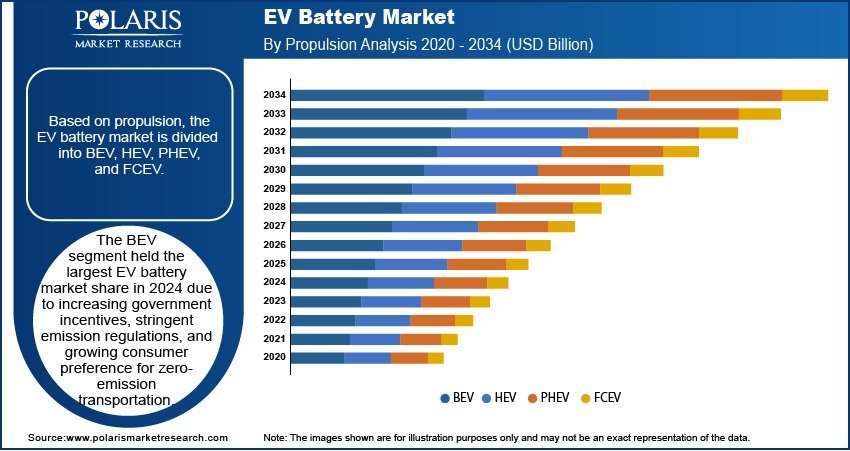EV Battery Market Projected to Reach USD 224.55 Billion By 2034, Growing at a CAGR of 9.5%

The global EV Battery market size was valued at USD 90.94 billion in 2024 and is projected to grow from USD 99.38 billion in 2025 to USD 224.55 billion by 2034 , exhibiting a Compound Annual Growth Rate (CAGR) of 9.5% during the forecast period from 2025 to 2034 .
- Surge in electric vehicles (EVs) Adoption: The rapid shift toward electric mobility driven by government policies, environmental concerns, and falling battery costs is fueling demand for high-performance EV batteries across passenger cars, commercial vehicles, and two-wheelers.
- Growth in Lithium-ion Battery Demand: Lithium-ion batteries remain the dominant technology due to their high energy density, longer lifespan, and declining production costs. Innovations in cell chemistry and fast-charging capabilities are further boosting adoption.
- Expansion of EV Manufacturing Hubs in Asia Pacific: Countries like China, Japan, and South Korea are leading global EV battery production, supported by strong government incentives, large-scale manufacturing facilities, and robust supply chains.
- Rising Investments in Battery Recycling and Sustainability: With increasing focus on circular economy models, companies are investing in recycling infrastructure and developing eco-friendly battery chemistries to reduce dependency on raw materials like cobalt and nickel.
- Development of Solid-State and Next-Generation Batteries: Automakers and battery manufacturers are investing heavily in solid-state batteries that offer higher safety, faster charging, and improved range—paving the way for next-generation EVs with enhanced performance.
- Market Size in 2024 – USD 90.94 billion
- Market Size in 2025 – USD 99.38 billion
- Projected Market Size by 2034 – USD 224.55 billion
- CAGR (2025–2034) – 9.5%
Electric vehicle (EV) batteries are the core power source for electric and hybrid vehicles, providing energy storage for propulsion and onboard systems. These batteries include various types such as lithium-ion (Li-ion), nickel-metal hydride (NiMH), and emerging technologies like solid-state, sodium-ion, and lithium-sulfur batteries. As governments worldwide push for decarbonization and zero-emission transportation, EV batteries have become central to the automotive industry’s transformation.
The market is experiencing exponential growth driven by rising EV sales, stringent emission regulations, and advancements in battery technology. Additionally, the expansion of charging infrastructure, growing consumer awareness, and decreasing battery pack prices are accelerating market adoption globally.
Technological innovation continues to shape the future of the EV battery industry. Companies are investing in R&D to improve energy density, reduce charging times, and enhance thermal management systems. Strategic partnerships between automakers, battery suppliers, and raw material providers are also strengthening the value chain. As electrification gains momentum across passenger and commercial vehicles, the EV battery market is poised for substantial growth over the next decade.


![Brazil Frozen Food Market Analysis: Opportunities, Innovations, and Growth Potential Through [2023-2032]](https://beeswire.com/wp-content/uploads/2025/07/polaris-72-768x768.png)



